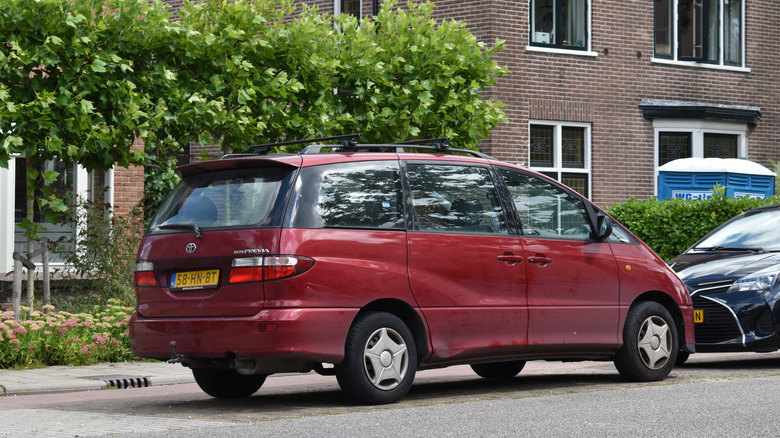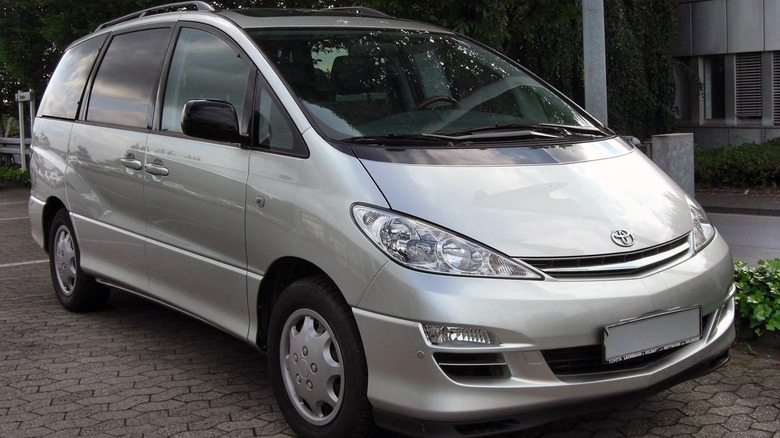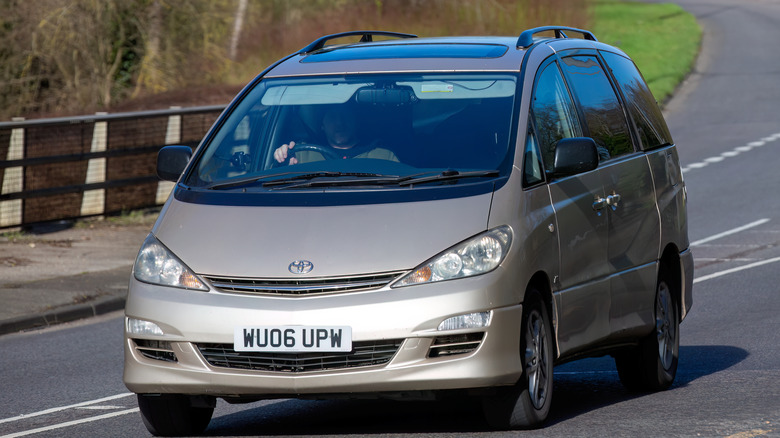Rumor Report: Here's What We Know About The Return Of The Toyota Previa
Since late 2024, rumors about a potential revival of the Toyota Previa minivan have been floating around, with different outlets weighing in on what this could mean for the Japanese carmaker's lineup. Toyota already has the well-loved Sienna minivan, which sold 75,037 units in the U.S. in 2024 — a big jump from 2023's 32,825. Hence, the idea of bringing in another minivan made some wonder whether there's a need for a different model in the same market segment. But considering that Toyota brought the Land Cruiser back in 2024 and revived another old badge for the sporty, affordable Supra, it's not out of the question that the Previa might make a comeback.
Toyota has yet to make any official announcement about the Previa's return, meaning any news about a new model is just wishful thinking at this point. Much of the ongoing speculation seems to have originated from an unconfirmed report in the Japanese magazine Best Car. The publication ran a story in December 2024 about a new Toyota Estima — the Japanese nameplate for the Previa. Details about the model are scarce, but it could potentially take cues from the Fine Comfort Ride concept car that Toyota unveiled at the 2017 Tokyo Motor Show.
Most of the other encouraging reports about a new Previa minivan reference the story published by Best Car, which leads us to believe that this is a case of outlets running with encouraging news without verifying it. Until we hear official word from Toyota that the Previa is coming back, SlashGear is going to refrain from joining this particular chorus.
The history and features of the Toyota Previa
Introduced in 1990, the Toyota Previa was anything but an ordinary minivan. It was sold as the Estima in Japan, the Tarago in Australia, and the Canarado in other markets, and was innovative for its time. Unlike its boxy competitors, the Previa sported a sleek, aerodynamic shape — earning it nicknames like the "egg van" or "spaceship." To maximize interior space, the Previa employed a cab-forward design that pushed the windshield over the front axle. This gave it a futuristic look that stood out on the road.
The Previa was also an anomaly with its mid-engine, rear-wheel-drive layout. Toyota placed the vehicle's 2.4-liter inline-four engine under the front seats at a 75-degree angle to optimize weight distribution and provide a lower center of gravity. This configuration, unheard of in the minivan segment at the time, resulted in superior handling and a more balanced ride despite its size. This unconventional design feature limited the use of larger engines, limiting the Previa's appeal in a market that increasingly favored power over innovation.
The Previa's interior offered ample space for up to eight passengers, with flexible seating configurations that allowed the passenger seats to fold flat or be removed entirely. This versatility made the Previa ideal for family road trips, cargo hauling, and daily commuting. Toyota also equipped the minivan with advanced features for its time, including All-Trac all-wheel drive, anti-lock brakes, and dual sunroofs. By the mid-90s, high-spec models like the GX featured captain's chairs, cruise control, and roof rails.
Why a revival would make sense for the Previa
Despite its forward-looking design and features, the Previa struggled to gain significant traction in key markets like the U.S. It had a higher price tag, lower fuel efficiency, and more unconventional styling than competitors like the Grand Caravan, which Dodge dropped a few years back. These quirks made the Previa a niche choice. Sales in the U.S. topped 50,000 units in 1991, but by its final year in 1997, Toyota sold less than 4,000 Previas in the United States. In Europe, the Previa enjoyed a slightly longer run, but it was eventually replaced there by more conventional models like Toyota's Sienna and Verso.
The Previa's discontinuation might have marked the end of a chapter for minivan enthusiasts, but the automotive landscape has shifted dramatically since the 1990s. Today, the demand for eco-friendly vehicles is reshaping consumer preferences. Toyota's expertise in hybrid and electric vehicle production positions it perfectly to revive the Previa in a way that aligns with current trends.
Forbes maybe took the rumors a step too far, reporting in late December that the new Previa will be built on Toyota's GA-K platform, which supports both battery electric (BEV) and plug-in hybrid (PHEV) powertrains. If actually implemented, this dual-powertrain strategy would allow Toyota to appeal to a broad audience. Eco-conscious buyers could opt for the EV, and anyone who prioritizes range or doesn't have access to a charger could purchase the hybrid. With U.S. sales of electric and hybrid vehicles on the rise, a dual-format Previa could be a game-changer.


